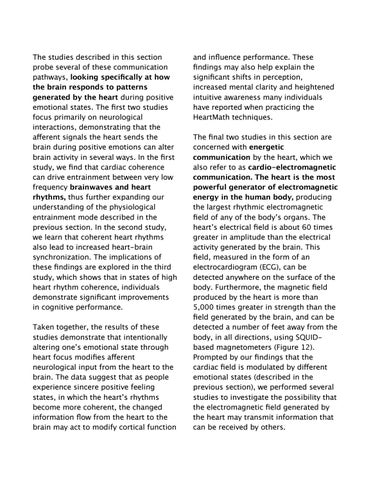fi
fi
ff
fi
fi
ff
fi
fi
fi
fi
fi
fl
fi
fi
fl
fi
fi
fi
Taken together, the results of these studies demonstrate that intentionally altering one’s emotional state through heart focus modi es a erent neurological input from the heart to the brain. The data suggest that as people experience sincere positive feeling states, in which the heart’s rhythms become more coherent, the changed information ow from the heart to the brain may act to modify cortical function
ff
fi
fi
fi
fi
The studies described in this section probe several of these communication pathways, looking speci cally at how the brain responds to patterns generated by the heart during positive emotional states. The rst two studies focus primarily on neurological interactions, demonstrating that the a erent signals the heart sends the brain during positive emotions can alter brain activity in several ways. In the rst study, we nd that cardiac coherence can drive entrainment between very low frequency brainwaves and heart rhythms, thus further expanding our understanding of the physiological entrainment mode described in the previous section. In the second study, we learn that coherent heart rhythms also lead to increased heart-brain synchronization. The implications of these ndings are explored in the third study, which shows that in states of high heart rhythm coherence, individuals demonstrate signi cant improvements in cognitive performance.
and in uence performance. These ndings may also help explain the signi cant shifts in perception, increased mental clarity and heightened intuitive awareness many individuals have reported when practicing the HeartMath techniques. The nal two studies in this section are concerned with energetic communication by the heart, which we also refer to as cardio-electromagnetic communication. The heart is the most powerful generator of electromagnetic energy in the human body, producing the largest rhythmic electromagnetic eld of any of the body’s organs. The heart’s electrical eld is about 60 times greater in amplitude than the electrical activity generated by the brain. This eld, measured in the form of an electrocardiogram (ECG), can be detected anywhere on the surface of the body. Furthermore, the magnetic eld produced by the heart is more than 5,000 times greater in strength than the eld generated by the brain, and can be detected a number of feet away from the body, in all directions, using SQUIDbased magnetometers (Figure 12). Prompted by our ndings that the cardiac eld is modulated by di erent emotional states (described in the previous section), we performed several studies to investigate the possibility that the electromagnetic eld generated by the heart may transmit information that can be received by others.
